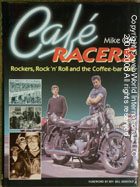By: Mike Clay
Published: in 1988 by Osprey Automotive, London
Hardcover; Dimensions: 8″ x 11″ (20.5×28 cm)
ISBN: 0850456770
Can be found for approx. $25.00
More: wBW Reviews Home | Book Reviews Index
We have been very fortunate to recently stumble upon a source of “NOS” (new old stock) motorcycle books. Some of these books are true classics; some are very rare; some are out of print and I think I can safely say that the vast majority of them are definitely obscure and out of the mainstream, which thrills me to no end.
I have always been of the opinion that deepening our understanding and knowledge of what has come before can help us better appreciate what we now have and what will come in the future.
This article is the first of an occasional series of webBikeWorld motorcycle book reviews that will describe the selections in this wonderful cache of motorcycle knowledge. Our hope is that you will discover something new, just as we have, and that you will become as inspired as we have been to deepen your knowledge of motorcycling history.
It’s thrilling to learn that a large body of work has been developed over the last hundred or so years about our sport, and it’s wonderful to learn that many who have come before us have been just as enthused and inspired as we are about the magic of motorcycling.
The book Café Racers is subtitled “Rockers, Rock ‘n’ Roll and the Coffee-bar Cult”. I decided to start with this book because the so-called café racer movement is really what inspired me to get involved in motorcycling, back in a time that seems both long ago and just yesterday.
There was something about the purposeful café racer styling that stunned me in a way that the American cruisers could not, and as I look back on my motorcycling career, the café racer is a thread that has run through it all.
Café racer style and the technology that ensued from racers’ demands to go ever faster has been one of the two major influences on motorcycling as we have known it in the last century or so. It may not seem that way to American riders, many of whom only think of Harley Davidson, Indian and the “One Percenters” as the primary inspiration for modern motorcycling.
But the café racer movement is responsible for the “other half” of street motorcycling as we know it; that is, the half of us (and I’m just guessing at the numbers) who don’t ride cruisers. Café racers were greatly frowned upon in the UK, just as the American rebels who started “bobbing” their Harleys after World War II were in the U.S.
The café racer movement inspired companies like Norton, Triumph and many others to finally modernize their designs to incorporate new technologies and styling that would serve this new market. The Italians followed suit with their big-bore examples, and although it seemed to me back in those days to take forever, the Japanese finally caught on. And just look what we have today — an absolutely magnificent choice of high-performance street bikes, many of which can trace their heritage, if not their design, to the café racer movement.
Perhaps you don’t know what the word “café” in café racer refers to? Mike Clay’s book does an excellent job of explaining it all, right from the “before the beginning”. The cafés (also known as “caffs”) were the Busy Bee on the A41, Johnsons on the A20, the Ace Cafe (now famous again) and others around London. The Rockers, in their leather jackets, rode and raced on the public roads and gathered at the “caffs” to tell about it, to talk bikes, to hassle the Mods and to hook up with “birds”, or “chicks”.
There’s far more history to this movement than I can relate, and I’d only be relaying what I’ve learned from others, so let’s just say that Café Racers by Mike Clay is the place to start. The book is filled with many rare black and white photos of the bikes, the people and the clothes of the era. I’m not sure where he got them all, but thank goodness for the camera buffs who had the foresight to take and keep these photos for our enjoyment.
Clay covers it all, and several of the chapters use the motorcycle icons of the era as a backdrop to explaining the life and times. The BSA Clubmans Gold Star, Triumph’s 650 and Norton motorcycles and their impact are described, and he explains how some of the modern bikes that we still see today are an outgrowth of the movement. Although there’s a chapter on the “Decline and Fall”, there’s also a chapter on the revival of the café racer, which is still thriving today, almost 20 years after the book was first written.
Café Racers even has an introduction by the Rev. Bill Sergold, otherwise known as the “Rockin’ Reverend”, who started the59 Club, which now claims to be the “largest motorcycle club in the world”.
Café Racers is a marvelous book that belongs on the bookshelf of any rider who is interested in the history of motorcycling. There are still brand-new copies available, so grab one before it’s too late.
wBW Rating:
More: wBW Book Reviews Index & the “Flaming Helmet” Rating System | All Reviewed Books Ranked by Rating
Note: For informational use only. All material and photographs are Copyright © webWorld International, LLC – 2000-2013. All rights reserved. See the webBikeWorld® Site Info page. NOTE: Product specifications, features and details may change or differ from our descriptions. Always check before purchasing. Read the Terms and Conditions!


